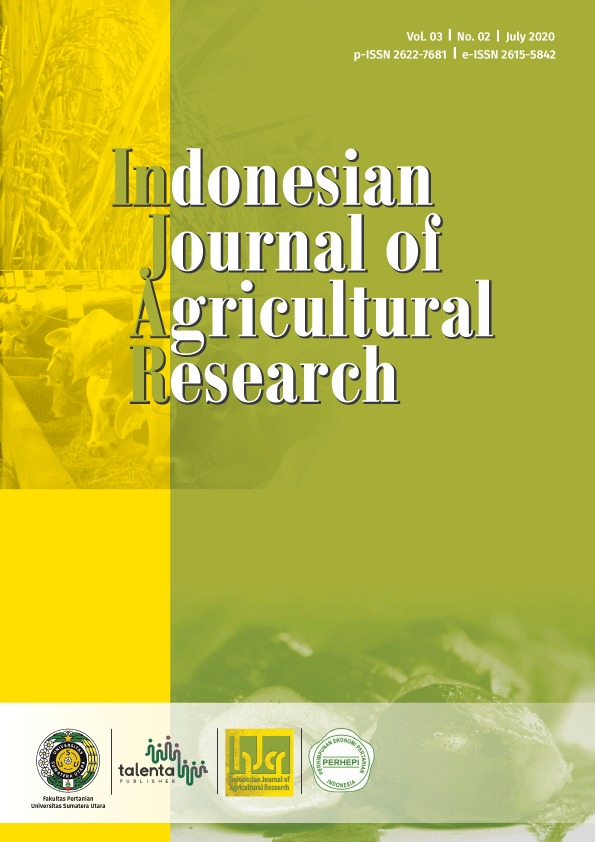Grain Yield Stability of Rice Genotypes
DOI:
https://doi.org/10.32734/injar.v3i2.3868Keywords:
environment, grain yield, Nepal, rice, stabilityAbstract
Stability analysis identifies the adaptation of a crop genotype in different environments. The objective of this study was to evaluate promising rice genotypes for yield stability at different mid-hill environments of Nepal. The multilocation trials were conducted in 2017 and 2018 at three locations viz Lumle, Kaski; Pakhribas, Dhankuta; and Kabre, Dolakha. Seven rice genotypes namely NR11115-B-B-31-3, NR11139-B-B-B-13-3, NR10676-B-5-3, NR11011-B-B-B-B-29, NR11105-B-B-27, 08FAN10, and Khumal-4 were evaluated in each location. The experiment was laid out in a randomized complete block design with three replications. The rice genotype NR10676-B-5-3 produced the highest grain yield (6.72 t/ha) among all genotypes. The growing environmental factors (climate and soil conditions) affect the grain yield performance of rice genotypes. The variation in climatic factors greatly contributed to the variation in grain yield. Polygon view of genotypic main effect plus genotype-by-environment interaction (GGE)Â biplot showed that the genotypes NR10676-B-53 and NR11105-B-B-27 were suitable for Lumle; NR11115-B-B-31-3 and NR11139-B-B-B-13-3 for Pakhribas; and 08FAN10 and NR11011-B-B-B-B-29 for Kabre. The GGE biplot showed that genotype NR10676-B-5-3 was stable hence it was near to the point of ideal genotype. This study suggests that NR10676-B-5-3 can be grown for higher grain yield production in mid-hills of Nepal.
Downloads
References
Krishi Diary, “Krishi Diary of 2079,†Government of Nepal. Ministry of Agriculture and Livestock Development, Kathmandu, Nepal, 2019.
B. K. Joshi, “Rice gene pool for tarai and inner tarai areas of nepal,†Nepal Agriculture Research Journal, vol. 6, pp. 24–27, 2005.
M. N. Paudel, D. R. Bhandari, M. P. Khanal, B. K. Joshi, P. Acharya, and K. H. Ghimire, “Rice science and technology in Nepalâ€, Crop Development Directorate (CDD) and Agronomy Society of Nepal (ASoN), Hariharbhawan, Lalitpur, Nepal and Khumaltar, Lalitpur, Nepal, 2017.
B. K. Joshi, K. P. Shrestha, and S. Bista, “Rice research report,†Proceedings of 23rd National Summer Crops Research Workshop 2-4 July 2002, Kathmandu, NARC HK Shrestha, B Chaudhary, EM Bhattrai and T Aktar, eds, 2003.
S. Sreedhar, T. D. Reddy, and M. S. Ramesha, “Genotype x environment interaction and stability for yield and its components in hybrid rice cultivars (Oryza sativa L.)â€, International Journal of Plant Breeding and Genetics, vol.5, no. 3, pp. 194-208, 2011.
M. S. Kang, “Simultaneous selection for yield and stability in crop performance trials: Consequences for growersâ€, Agronomy Journla, vol. 85, pp. 754-757, 1993
M. Dingkuhn, D. Luquet, H. Kim, L.Tambour and A. ClementVidal, “Ecomeristem, a model of morphogenesis and competition among sinks in rice.2. Simulating genotype responses to phosphorus deficiency†Functional Plant Biology, vol. 33, pp. 325-337, 2006
R. O. Torres and A. Henry, “Yield stability of selected rice breeding lines and donors across conditions of mild to moderately severe drought stressâ€, Field Crops Research, vol. 220, pp. 37-45, 2018.
S. A. Eberhart and W. A. Russell, “Stability parameters for comparing varietiesâ€. Crop Science, vol. 6, no. 1, pp. 36-40, 1966.
J. D. Bilbro and L. L. Ray, “Environmental stability and adaptation of several cotton cultivarsâ€, Crop Science, vol. 1, no. 1, pp. 821- 824, 1976.
NARC, “Annual Report (2017/18) of Nepal Agricultural Research Council (NARC), Hill Crops Research Program, Kabre, Dolakha, Nepalâ€, 2018
NARC, “Annual Report (2017/18) of Nepal Agricultural Research Council (NARC), Agricultural Research Station, Lumle, Kaski, Nepalâ€, 2018
NARC, “Annual Report (2017/18) of Nepal Agricultural Research Council (NARC), Agricultural Research Station, Pakhribas, Dhankuta, Nepalâ€, 2018.
NARC, “Annual Report (2017/18) of Nepal Agricultural Research Council (NARC), National Commercial Agriculture Research Program, Pakhribas, Dhankuta, Nepalâ€, 2018.
NARC, “Annual Report (2017/18) of Nepal Agricultural Research Council (NARC), Hill Crops Research Program, Kabre, Dolakha, Nepalâ€, 2018
NARC, “Annual Report (2017/18) of Nepal Agricultural Research Council (NARC), Regional Agricultural Research Station, Lumle, Kaski, Nepalâ€, 2018
S. Marahatta, “Increasing productivity of an intensive rice based system through site specific nutrient management in western terai of Nepalâ€, The Journal of Agriculture and Environment, vol. 18, pp. 140-150, 2017.
S. A. Eberhart and W. A. Russell, “Stability parameters for comparing varietiesâ€, Crop Science, vol. 6, no. 1, pp. 36-40, 1966.
K. A. Gomez and A. A. Gomez, Statistical Procedures for Agricultural Research. 2nd ed.†NY, USA: John Wiley and Sons, 1984
R. Payne, D.A. Murray, S. A. Harding, D.B. Baird and D.M. Soutar, “Genstat for Windows (12th Edition) Introduction, VSN International, UK: Hemel Hempstead, 2009.
A. Pacheco, M. Vargas, G. Alvarado, F. RodrÃguez, M. López, J. Crossa, J. Burgueño, “User’s Manual GEA-R (Genotype by Environment Analysis with R). GEA-R (Genotype x Environment Analysis with R for Windows) Version 4.1", CIMMYT Research Data and Software Repository Network, V16, 2015.
A. Akter, M. J. Hasan, U. Kulsum, M. H. Rahman, M. Khatun, and M. R. Islam, “GGE Biplot Analysis for Yield Stability in Multi-environment Trials of Promising Hybrid Rice (Oryza sativa L.)â€, Bangladesh Rice Journal, vol. 19, no.1, pp. 1– 8, 2015.
Z.F. Saied, “Survey of adaptation of thirty rice (Oryza sativa L.) genotypes to west Guilan climatic conditions-Astara†Journal of Crop Ecophysiology, vol. 4 no. 15, pp. 111–126, 2010.
S. Tariku, T. Lakew, M. Bitew and M. Asfaw, “Genotype by environment interaction and grain yield stability analysis of rice (Oryza sativa L.) genotypes evaluated in north western Ethiopiaâ€, Net Journal of Agricultural Science, vol. 1, no. 1, pp 10–16, 2013.
P. Sharifi, H. Aminpanah, R. Erfani, A. Mohaddesi and Abbasian, “Evaluation of Genotype × Environment Interaction in Rice Based on AMMI Model in Iranâ€, Rice Science, vol.24, no.3, pp:173-180, 2017.
K.W. Finlay and G.N. Wilkinson, “The analysis of adaptation in a plant breeding programmeâ€, Australian Journal of Agricultural Research, vol. 14, pp. 742-754, 1963.
Downloads
Published
How to Cite
Issue
Section
License
Copyright (c) 2020 Indonesian Journal of Agricultural Research

This work is licensed under a Creative Commons Attribution-ShareAlike 4.0 International License.



















